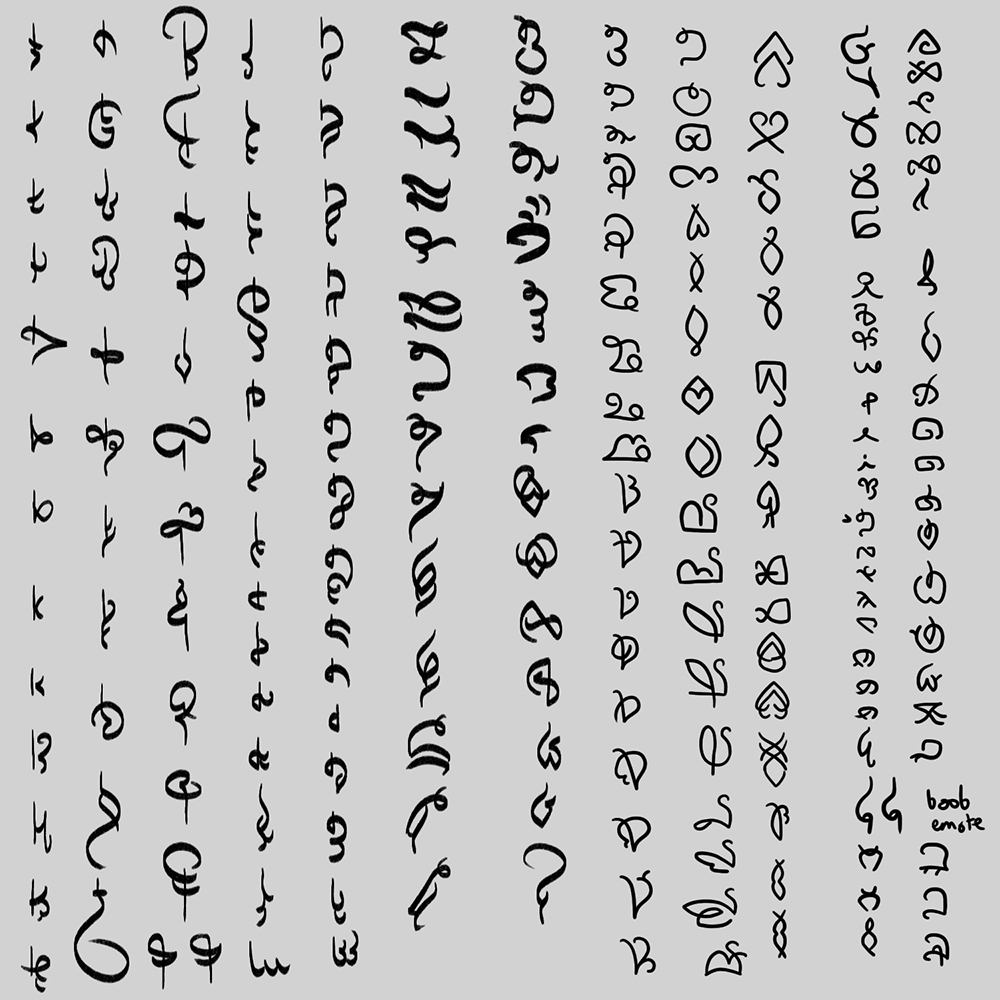
Nawdd Vuwcid
| DATE | 2018-2021 |
| GENERAL RULES | Stress generally on first syllable |
| WORD ORDER |
Marker-Article-ADJ-Subject-Article-ADJ-Object-Verb.Tense-ADV Word order does not change for questions. |
| INSPIRATION | Panorama of a train by Rhiannon Rasmussen |
| RELATED |
Guide to Kroma Zhavise language Addij Vujid language Jumble script |
Vuwcid is the second conlang I fleshed out for the Kroma setting. After working on Zhavise, the world's lingua franca, I wanted to bite into something more grammatically complex and less regular.
Vuwcid ("voo-chid") is mainly spoken in the east of Shungvales, particularly in the Moss Mountains separating the north-east coast from the Zhavise region. The Vuwcid capital is Vinnor, situated in the northern mouth of The Herds and home to the Eddlyr Uts, who serve the same purpose as Kroma's Oroshadan.
The region today known as Etuji is also historically Vuwcid, but due to the spread of Oroshadan knights over the years Etuji cities now primarily use Zhavise or Addij Vujid (Bay Vuwcid). The Zhavise spoken in Etuji has not been hugely influenced by Vuwcid, though it is common for northern Zhavise speakers to use Vuwcid state markers (see below) as slang. ro is particularly popular and it often goes misused by southern Zhavise speakers, much to the chagrin of native Vuw. Traditional Nawdd Vuwcid spoken in the east is often mocked by Etuji speakers for sounding like one is speaking around a mouthful of food.
Phonology
| LETTER | SOUND | LETTER | SOUND | LETTER | SOUND | ||
| k* | k | c** | tʃ | i | i/ɪ | ||
| nn* | ñ | m/n** | m/n | iw | ɥ | ||
| d* | d | dd** | dʒ | u | ʊ | ||
| p* | p | b** | b | uw | u | ||
| t | t | l | l | o | ɔ | ||
| r | ɹ | s | s | oi | ɔɪ | ||
| v | v | w | w | a | æ | ||
| f | f | y/yo | i/j/joʊ | aw | ɒ | ||
| e | ε |
Vowels belong to two categories, "base" and "pocket" vowels. Every base vowel has a pocket*** form:
- i → iw
- u → uw
- o → oi
- a → aw
"Loose" vowels do not fit in the base or pocket categories:
- y/yo - always end a word and are never in the middle
- e - never on a stressed syllable
Base vowels are always pronounce individually and do not form diphthongs (eg. liuwik would be pronounced "lih-oowick" rather than "lyoowick"). Pocket vowels are pronounced as diphthongs.
Pronouns
There are a wide range of third-person pronouns, though these are separated by age rather than gender. First-person and second-person pronouns do not differ by age.
| SUBJECT | OBJECT | REFLEXIVE | |
| 1st person (single) | vly | von | vidda |
| 1st person (plural) | siw | sin | sadda |
| 2nd person | kyo | kon | kidda |
| 3rd person (non-specific person or a group of people of multiple ages) | syo | son | sodda |
| 3rd person (baby) | bibiw | bibon | bibba |
| 3rd person (young children) | byo | bon | byodda |
| 3rd person (teenagers) | abyo | abon | bodda |
| 3rd person (20's) | diyo | don | dodda |
| 3rd person (30's and 40's) | dyo | don | dodda |
| 3rd person (50's+ with grandkids) | pyo | pon | padda |
| 3rd person (50's+ without grandkids) | apyo | apon | apadda |
Possessives are formed using the viw ("at") construction: the noun at owner. The noun must be accomapanied by the definite article.
| POSSESSIVE | EXAMPLE | |
| 1st person (single) | viwvly | ofa ciw viwvly, "my bird" |
| 1st person (plural) | viwsiw | ofa ciw viwsiw, "our bird" |
| 2nd person | viwkyo | ofa ciw viwkyo, "your bird" |
| 3rd person (non-specific person or a group of people of multiple ages) | viwsyo | ofa ciw viwsyo, "their bird" |
| 3rd person (baby) | vibibiw | ofa ciw vibibiw, "their bird" |
| 3rd person (young children) | viwbyo | ofa ciw viwbyo, "their bird" |
| 3rd person (teenagers) | vabyo | ofa ciw vabyo, "their bird" |
| 3rd person (20's) | vidiyo | ofa ciw vidiyo, "their bird" |
| 3rd person (30's and 40's) | viwdyo | ofa ciw viwdyo, "their bird" |
| 3rd person (50's+ with grandkids) | vipyo | ofa ciw vipyo, "their bird" |
| 3rd person (50's+ without grandkids) | vapyo | ofa ciw vapyo, "their bird" |
Verbs
Verbs are separated into three categories: non-phsyical ("to be"), vague physical ("to have"), and actual physical ("to sing"). Each verb category has a different conjugation ruleset. All verbs conjugate according to subject.
|
NON-PHYSICAL oatir "to be" |
VAGUE PHYSICAL ciwpin "to have" |
ACTUAL PHYSICAL eddoalik "to sing" |
|||
|---|---|---|---|---|---|
| vly | oatab | vly | ciwpib | vly | eddoalab |
| siw | oatinn | siw | ciwpinn | siw | eddoalinn |
| kyo | oato | kyo | ciwpyo | kyo | eddoalo |
| syo | oatib | syo | ciwpid | syo | eddoaloi |
| MARKER | TENSE | EXAMPLE |
| none | present | vly oatab, "I am" |
| aot | future | vly oatab aot, "I will be" |
| oit | past | vly oataboit, "I was" |
| apt | imperative | oatir apt, "be!" |
| iddaot | future past | vly oatab iddaot, "I will have been" |
| iddoit | past perfect | vly oatab iddoit, "I had been" |
| adda | present progressive | vly oatab adda, "I am being" |
Nouns
Nouns have two genders, "high" and "low"
- odd - high indefinite article
- od - low indefinite article
- ef - high definite article
- ofa - low definite article
Plurals also change according to gender
- -il - high plural
- -ol - low plural
Adjectives
Adjectives must agree with high nouns:
- The final consonant of the adjective must harden.
- If the final consonant is already hard, then the final vowel pockets.
- If the final consonant is already hard and the final vowel already pocketed, then nothing changes.
Adjectives do not need to agree with low nouns
| ADJECTIVE | HIGH NOUN | LOW NOUN |
| annin, "good" |
odd anniwn faw, "a good morning" |
od annin ciw, "a good bird" |
| ipad, "big" |
odd ipadd apanoi, "a big tower" |
od ipad tuwly, "a big cat" |
When describing yourself or a person, you do not use adjectives. Instead, you say that you have a characteristic:
- od ipad tuwly, "a big cat"
- BUT: vly ciupib ipa, "I am tall" (literally "I have tall height").
- ef anniwn pidd, "the good name"
- BUT: kyo ciwpyo annina, "you are good" (literally "you have goodness").
State Markers
State markers are an important feature of Vuwcid which go at the very beginning of the sentence and introduce the mood of the phrase. There are four state markers:
- ro - positive sentence
- py - negative sentence
- cy - question
- so - hypothetical sentence
ro and py don't make a statement positive or negative by themselves, but they reinforce the positivity or negativity. A sentence like "py I like cabbage" doesn't mean "I don't like cabbage", it means "I like cabbage... wiggly eyebrows so you know I'm not telling the truth.
cy must be placed at the beginning of every question to turn a statement into a question, similar to Japanese ka.
Example sentences
-
English: The cat stole my dinner
Vuwcid: ofa tuwly ikkaloi oit ofa epa viwvly
Transliteration: the cat steal past the dinner at-me -
English: Stop asking me to dance
Vuwcid: naddalo apt ep kyo abuddiyo von luvik
Transliteration: you-stop imperative that you ask/request me to-dance
Writing system
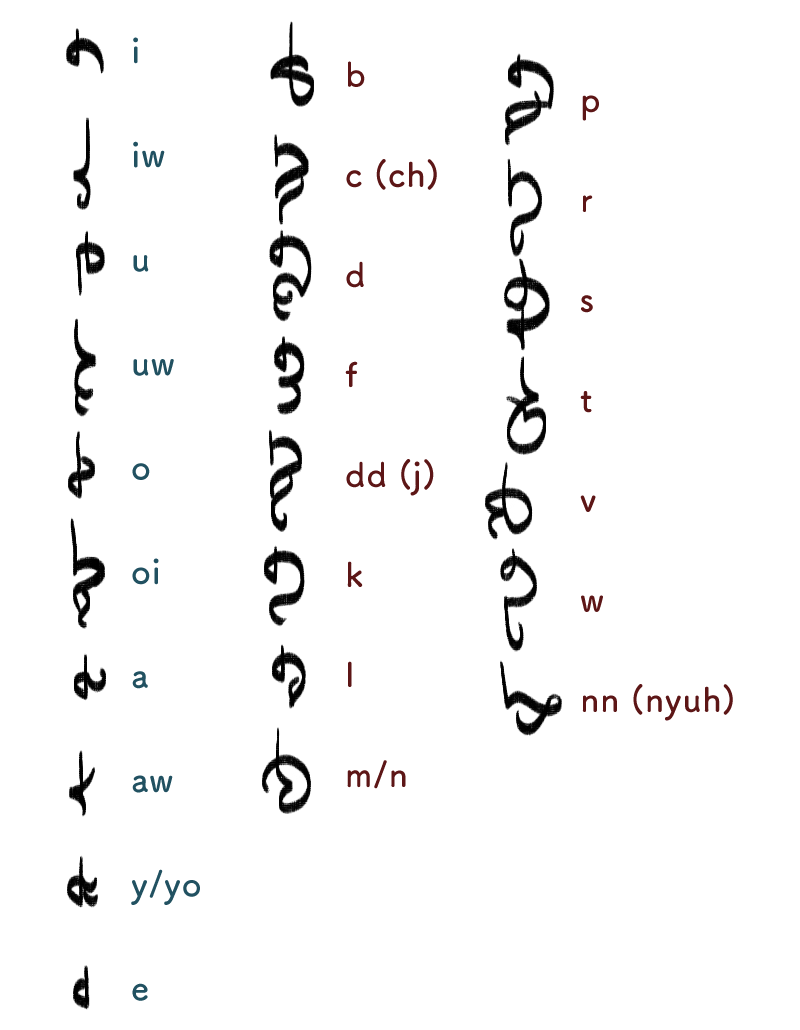
Similar to the Zhavise script, Vuwcid is written top to bottom, left to right. Vuwcid wasn't restricted to the rigidity of blockprinting, however, so it is a very loose and decorative script, traditionally written with a chisel tipped pen. Letters do not connect, but the "stem" of each letter begins along the same central line.
State markers are not written in full, but are instead indicated with the following glyphs. The "neutral" glyph is only used in writing to indicate a stateless phrase and is not spoken aloud.

Examples
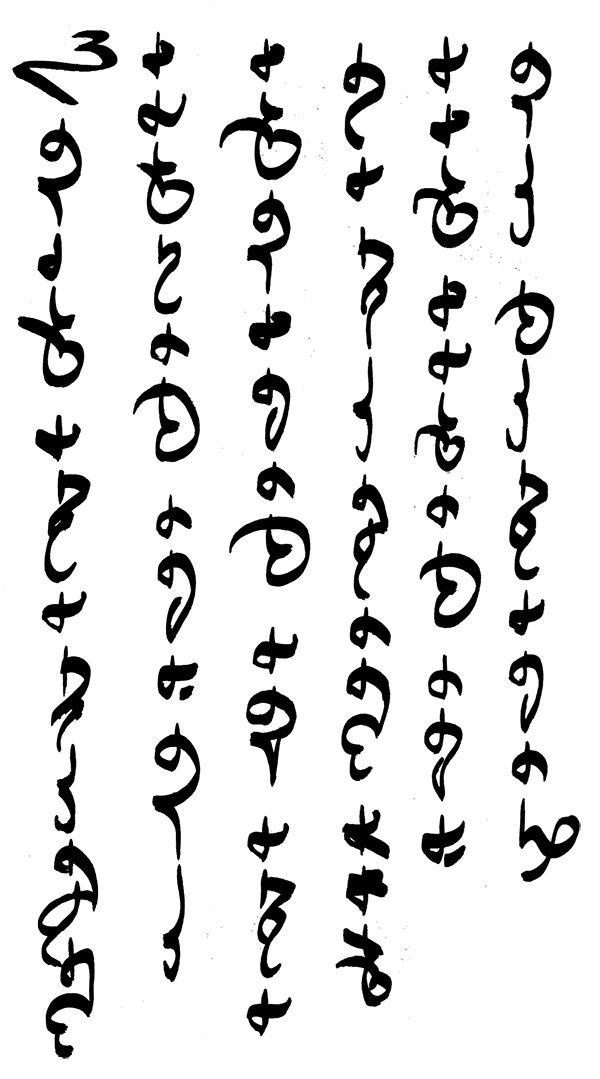
So set adda ciwpid oatrin ilyo siw otsolinn as adda ka ciwpid aot oatrin ilyo siw niwddalinn. (on left)
"If your mouth is closed when you're cooking, then it will be closed when you're eating." Singing while you cook is important to Vuwcid culture and there are hundreds of songs written to be sung during the preparation of specific meals.
Development
Vuwcid started life years before Kroma even existed, as a botched panorama of a train taken by Rhiannon Rasmussen. I was really taken by the jumble of letters on the side of the train and decided to see what I could turn it into. I love doing this, developing whole languages from one picture of some weird wiggly lines. If you ever have a weird wiggly line picture and you think it would make a cool script send it my way.

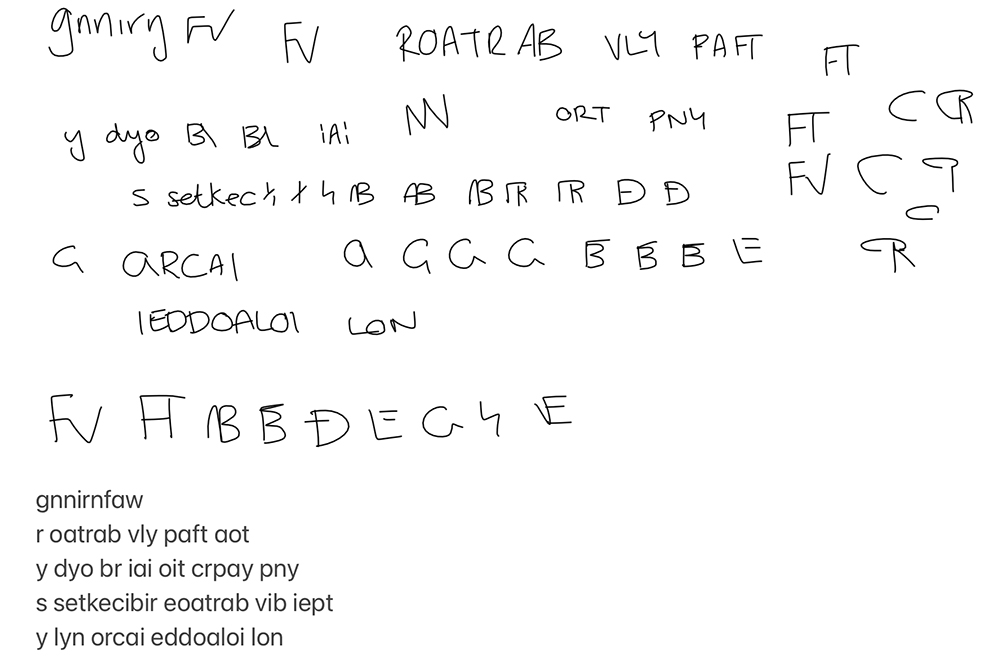
I directly transcribed the "words" in the photo and used them as the jumping off point for a grammar. Below are my original notes; you can see that the bones of Vuwcid were there from the very beginning.
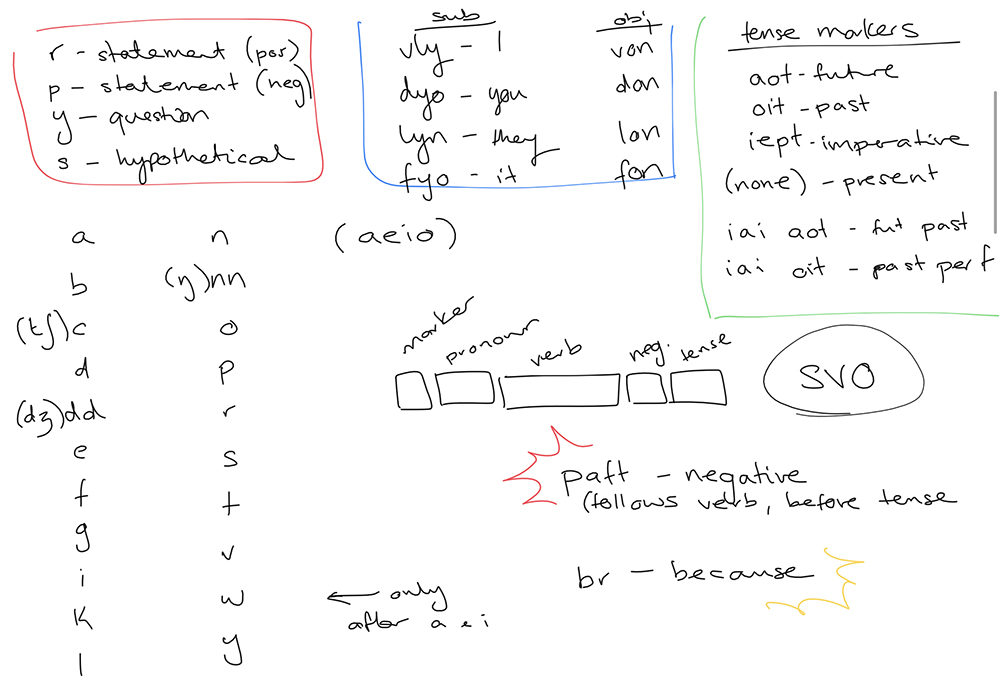
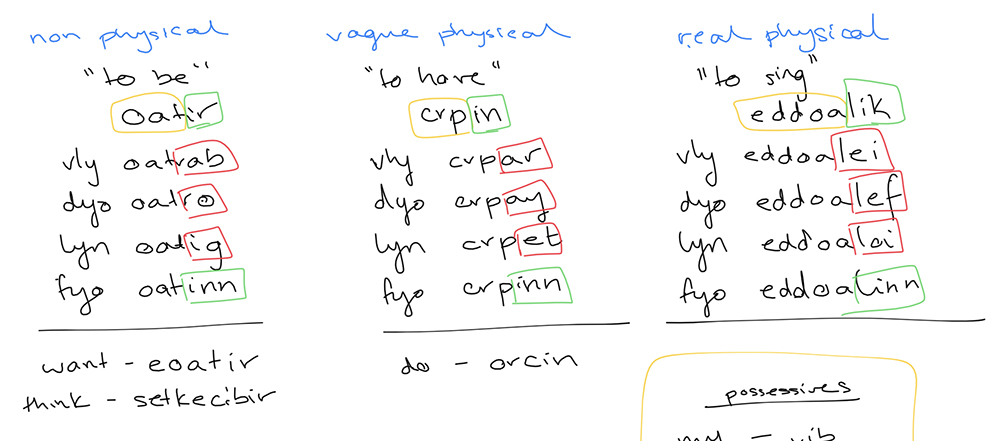
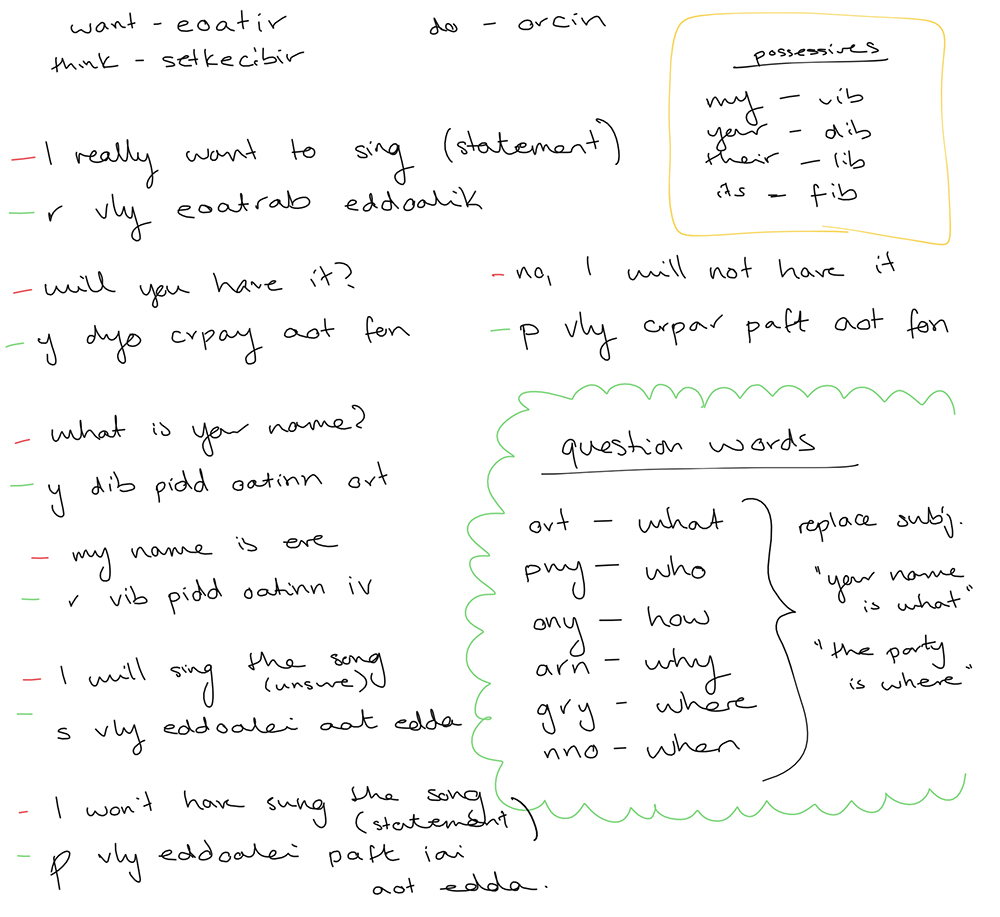
When Spire and I started discussing developing Vuwcid, I had a language basically ready to go. The next question was what it would look like; I had already considered using my Scarab script for this language, but I didn't think it fit quite right. I showed Spire what I'd done with my Jumble script as another option and we decided to use that as a base for the direction we wanted to go. Spire put together some glyph ideas, I picked out my favourites, and the Vuwcid script was born.
